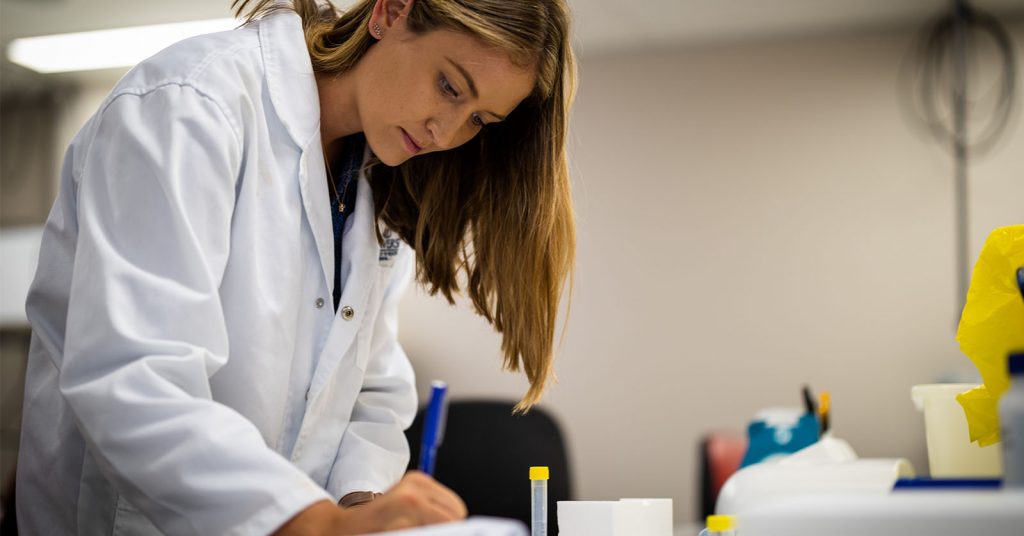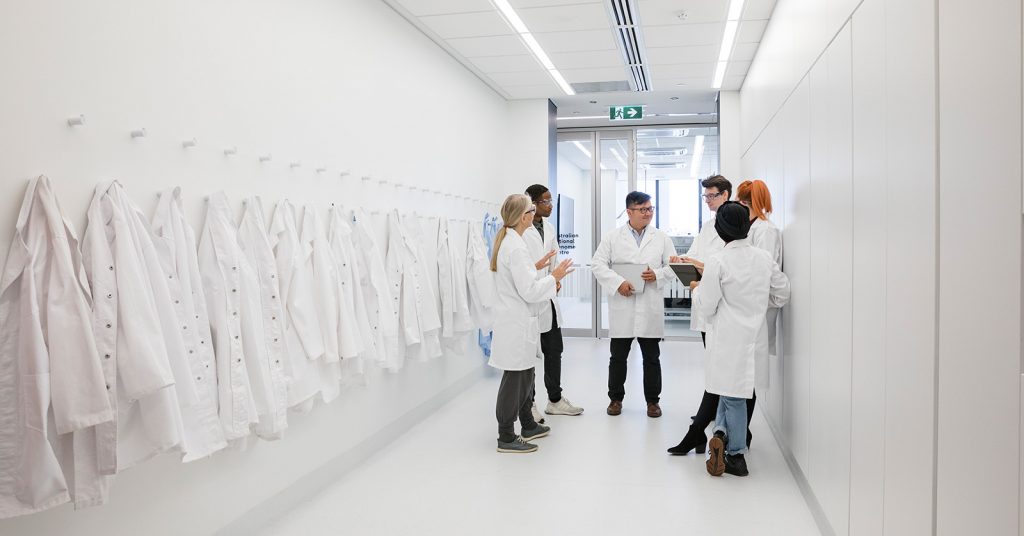Thinking of becoming a pharmacist? Community pharmacists play a really important role, ensuring that people have informed access to the medications they need and providing advice on a huge range of different health and wellbeing issues. In rural and regional Australia especially, where it can be more difficult to access GPs, the local pharmacist will often be the closest and best person to ask about… well, almost anything!
Pharmacists also go through years of pharmacy courses and must complete a registration exam, so they know their stuff. They (and the pharmacy they work in) have to work hard to remain accredited with regulatory boards like the Australian Health Practitioner Regulatory Agency (AHPRA). They’re constantly learning about new medications, dosage requirements and other changes in the wider health community. They’re a powerhouse of knowledge across a broad collection of health disciplines.
So you want to become a pharmacist, and help people stay healthy and well? Taking on a Bachelor of Pharmacy1 with Charles Sturt is a great way to start the journey to become a pharmacist.
Why choose a career in pharmacy?
People will always need medications, vaccinations, high-quality health advice and support – so they’ll always need pharmacists! There’s a fast-growing need for pharmacists in Australia, too: according to the Pharmacy Guild of Australia, demand for full-time equivalent (FTE) roles in pharmacy nearly tripled the amount of new registrations in 20232.
In regional areas, the divide between demand and supply becomes even more stark. The Pharmaceutical Society of Australia predicts that there could be as few as 52 pharmacists per 100,000 people in regional and remote areas by 2027. That’s compared to an estimated 113 per 100,000 in the major cities – more than double.
Benefits to considering pharmacy as a career path:
- High employability: As we mentioned above, lots of open roles means your skills will be in short supply anywhere you choose to look.
- Strong salary potential: According to seek.com.au, the average salary for a pharmacist is around $95,000–$115,000 a year. Ka-ching.
- Diverse roles across hospitals, community and industry: You don’t just have to work in a local pharmacy. With your skills you could work as a hospital pharmacist or even lend your knowledge to health advocacy and the public sector. With a degree in pharmacy in your pocket, you could also choose to move into research and drug development, whether for government or private industry.
- Opportunities for health leadership: Your expertise across a range of health disciplines and your community connections mean you’re a great candidate to move up the ranks and specialise into a specific leadership path. You could advise on the pharmaceutical industry or even help administer the exams for new pharmacists, just like you were!
Making the decision to become a pharmacist means choosing a career that’s got guaranteed job security, the flexibility to travel and practice anywhere, and the opportunity to make a real difference in the health and wellbeing of everyone around you.

What does a pharmacist do?
From regional, rural and remote towns to the big cities, pharmacists are an integral part of primary healthcare. They are medicine experts who dispense prescription medications for acute illness and for chronic conditions such as asthma, arthritis and heart conditions. But that’s not all. Pharmacists are responsible for:
- dispensing medications safely
- providing health advice and counselling
- managing medication therapy
- collaborating with other healthcare professionals
- conducting health promotions and vaccination
- ensuring regulatory compliance.
Want to know more? Check out a day in the life of a pharmacist:
Your four-step pathway to pharmacy registration
To become a pharmacist in Australia, you must:
- Complete an accredited pharmacy degree
- Undertake a pharmacy internship
- Pass the pharmacy boards
- Apply for general registration
Step one: Complete an accredited pharmacy degree
Completing a degree like our Bachelor of Pharmacy1 with Charles Sturt is your first step toward becoming a registered pharmacist. The course is professionally accredited by the Australian Pharmacy Council, so you know you’re getting the best of the best.
The course covers topics like:
- biology and human anatomy
- disease and immunology
- pharmacology
- First Nations health and wellbeing
- pharmaceutical science
- patient counselling.
You’ll also get work-integrated learning and real-world clinical placements that will give you first-hand experience working in a community pharmacy. Studying pharmacy with Charles Sturt means a study experience and campus life that’s next to none, while also ensuring you’re getting supervised practice and real-life experience in pharmacy. It’s a win-win!
If you’ve completed relevant tertiary study, or work experience related to your course, you could receive credit towards your degree, which could mean completing your qualification quicker. Find out how to apply for credit and see our credit policy.
We also have several admission pathways to help you take the step into your preferred course, even if you don’t quite meet the entry requirements at first.
Step two: Undertake a pharmacy internship
To continue your journey to becoming a registered pharmacist, you’ll have to complete some intern training with a more experienced pharmacist as your guide and mentor.
You’ll get a provisional registration, and you’ll have to perform a minimum number of supervised practice hours in an arrangement that’s been approved by the Pharmacy Board of Australia. During this time, you’ll be considered an ‘intern pharmacist’.
This is your chance to soak up all that knowledge and experience like a sponge. Ask questions. Stay curious. Get involved. And don’t be afraid to speak up and ask for more opportunities to learn and grow as a pharmacist. This is the best time to do it!
Step three: Pass the pharmacy boards
You’re almost there! You’ve put in the hard yards, completed your supervised hours, and learned everything there is to know about being a pharmacist. What’s next?
Check the list to make sure you’ve got everything ready. You can submit your application once you’ve completed more than 75 per cent of your required practice hours. Exam guides are available, and the Australian Pharmacy Council even has a helpful collection of resources!
Once you successfully complete all of your provisional requirements, you can apply to take the Board registration exam. This consists of a written section judged by members of the Australian Pharmacy Council (APC), and a speaking section judged by the Australian Health Practitioners Regulatory Agency (AHPRA).
Then once you’re successful, you can…
Step four: Apply for general registration
You’ve done it! You’ve been certified by all the most important pharmaceutical bodies in Australia that you really know your stuff. Now you can apply for provisional to general registration.
Applying is easy: you can do it online. You’ll usually find out whether you’ve been approved for general registration within two weeks. You’ll have to pay a fee, plus an annual registration to stay registered with the Australian Pharmacy Board.
Once you’ve been registered as a fully-qualified pharmacist, you can start working unsupervised! Your name will be added to the AHPRA Register of Practitioners. Then everyone can see that you’re someone who can be trusted with health advice and medication.
It’s now your responsibility to keep up with continuing professional development (CPD) to maintain your licence. It’s not one and done: you’re going to be constantly learning about new medicines, changes to policies or provisions, and staying current with ever-evolving pharmacy practice. Consider it your opportunity to be always learning and growing.
What you’ll study
Let’s take a little deep dive into the study options in our Bachelor of Pharmacy.
Biology and human anatomy
Get into the nitty gritty of human molecular biology so you can understand the way medicines work in our bodies. You’ll need a deep understanding of the human body. How else can you best advise on how to keep it healthy?
Disease and immunology
How do diseases grow, spread and thrive? What makes them so dangerous? How can we keep people safe from different diseases, and what might the next big disease be?
First Nations health and wellbeing
First Nations approaches to community health and wellbeing may be different to other people’s. In these subjects, you’ll learn culturally conscious practice so you can help everyone in every community in a way which is respectful of their cultural differences.
Pharmaceutical science
Dive into the fascinating world of pharmaceutical science, where you’ll uncover interesting truths about the chemistry, mechanics and technology of medicines and human biology.
Patient counselling
As a pharmacist, you’re not just doling out pills – sometimes you are a person’s only lifeline to a more informed health journey and quality use of medicines. You’ll learn more about how to use your soft skills to help keep people safe, physically and emotionally, whether that’s telling them which medications to choose or giving them great life and relationship advice.
You can find more info about each of these segments in the student handbook.

Why choose to study pharmacy at Charles Sturt?
Our Bachelor of Pharmacy is fully accredited by the Australian Pharmacy Council, so you’re in safe hands.
You’ll receive personalised attention and instruction from highly-qualified teaching staff, including registered pharmacists with extensive industry links and experience. You’ll practice what you’re learning in the classroom in state-of-the-art laboratories and a pharmacy simulation setting, along with hands-on workplace learning.
Then there’s the soft skills that allow pharmacists to work effectively with people of all ages and backgrounds, including communication and interpersonal skills, time management, decision-making and problem-solving.
Charles Sturt is a regional uni, which means our courses provide you with a unique perspective and understanding of the health needs of rural and regional Australians.
Plus, you’ll study with the #1 uni in Australia for grads who get jobs3. So what are you waiting for? Reach out to find out how you can start your pharmacy career journey now.

How long does it take to become a pharmacist?
It usually takes about four years of full-time study to become a pharmacy intern. Though if you’ve completed any related degrees or have work experience in the field you may be able to accelerate your study. Then you’ll have to complete your registration exam, plus around 1,600 hours of supervised practice, in order to register to become a fully-qualified pharmacist.
How much do pharmacists earn?
According to seek.com.au, the average salary for a pharmacist in Australia is between $95,000–$115,000.
Can I study pharmacy online?
The Bachelor of Pharmacy at Charles Sturt is taught on campus in Orange. You’ll gain the benefits of hands-on learning in pharmaceutical practice and theory, getting invaluable experience in our lab settings and on-campus intensive schools.
1 Course CRICOS 022016K
2 Pharmacy Workforce Supply and Demand Report 2023
3 Public universities, Good Universities Guide 2024/25


You must be logged in to post a comment.